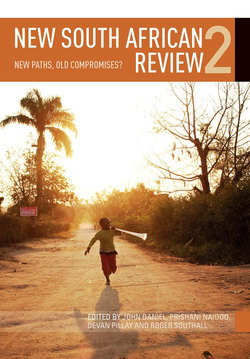Читать книгу New South African Review 2 - Paul Hoffman - Страница 17
На сайте Литреса книга снята с продажи.
THE NATIONAL DEMOCRATIC REVOLUTION (NDR)
ОглавлениеThere has been a long history of alliance-building between the nationalist liberation movement and working-class formations. From 1924, the Communist Party of South Africa (CPSA) theorised that the overthrow of capitalism could not occur through a ‘pure’ class struggle between the bourgeoisie and the proletariat. The pivotal 1922 white mineworkers strike disabused them of the hope that white workers could be in the vanguard of the class struggle against capitalism because the white mine-workers were too racist, and saw their salvation in white nationalism and the job colour bar (Simons and Simons, 1983). While class exploitation was the ‘primary’ or ‘fundamental’ contradiction, the ‘dominant’ contradiction in the colonial context was that between the colonised people and the white supremacist state. In other words, colonial oppression provoked an anti-colonial and nationalist consciousness within the majority of the population.
The task of communists was to play a leading role in the black nationalist movement to bring about national democracy in the ‘first stage’ through a multiclass alliance against white rule, and to proceed to socialism in the ‘second stage’, which would be ensured by building working-class power at the point of production through strong industrial unions and in communities (through various kinds of working-class civic formations). The CPSA did not abandon hope of building a nonracial working-class movement, and continued to organise among white workers, but on the whole their activities during the 1930s and 1940s increasingly involved organising black workers and working within the ANC. Communists wanted to ensure that African nationalism would, at worst, not be anti-communist and would, at best, be modernist, be increasingly nonracial, be anti-imperialist, and have a working-class bias. It would not, however, be explicitly socialist, as this would detract from its broad appeal.
This ‘two-stage’ character of the NDR attracted much criticism from those to the left of the CPSA, who felt that it owed too much to Joseph Stalin’s ‘bastardisation’ of revolutionary Marxism-Leninism, unlike the Leninist-Trotskyist notion of ‘permanent revolution’, one ‘uninterrupted’ socialist revolution led by an independent working class party that was not subordinated to nationalism (for example, see Legassick, 2007).
When the CPSA was banned in 1950 following increased mass mobilisation after the apartheid government came to power in 1948, it disbanded and re-formed underground in 1953 as the SACP. Leading members played a key role in setting up the white Congress of Democrats (COD) and bolstering the South African Indian Congress (SAIC) and Coloured Peoples’ Congress (CPC). Communists were also central to the formation of the South African Congress of Trade Unions (Sactu) in 1955. The informal and semi-formal expressions of alliance politics in the 1940s now took on a more formal character with the 1955 Congress of the People at which the Freedom Charter (which served as the binding document of the Congress Alliance composed of the SAIC, CPC, COD, Sactu and the ANC, with the latter seen as the leading component) was launched. This has remained a key reference point for the current Tripartite Alliance.
The Freedom Charter melded together liberal-democratic freedoms and socialistic aspirations such as the nationalisation of the commanding heights of the economy, land redistribution and social welfare. While not a socialist or anti-capitalist document in the hard sense of the term, it had a strong social-democratic flavour in keeping with sentiments popular among post-war ruling parties in northern European countries. This gave it broad appeal. On the one hand, Nelson Mandela could assert that it opened up opportunities for ‘non-European’ entrepreneurship, while on the other the communists could point to the Charter as a stepping stone towards socialism – but as a result the document could also be denounced by right critics for being ‘communist’ and by leftists for fudging the question of socialist advance. The influence of white communists in the drafting of the Charter also alienated Africanists, resulting in the splitting-away of the Pan-Africanist Congress (PAC) in 1959. Although this did not remove a narrow Africanism from the ANC, it helped pave the way for a more inclusive nonracial nationalism.
Communists were at the forefront of placing emphasis on an inclusive, cross-class nonracialism within the liberation movement, and while its theory of colonialism of a special type implicated capitalism in the rise of colonialism and apartheid, in practice it de-emphasised class divisions in the interests of nationalism (Wolpe, 1987). However, proletarian assertions coming from an increasingly mobilised trade union movement gave confidence to those arguing for a leading role for the working class in the ‘revolutionary alliance’.
After the ANC was banned in 1961, the movement in exile absorbed all sections of the alliance into its ranks, in effect making it a nonracial organisation, although it was only in 1985 at the Kabwe conference that the ANC formally admitted ‘non-Africans’2 into the ANC. At its 1969 Morogoro conference in Tanzania, the ANC recognised the ‘leading role’ of the working class. However, the ANC remained vague as to whether the working class was ‘leading’ because of its potentially anti-capitalist, pro-socialist orientation, or because it was merely the majority within the black population. This deliberate fudging was deemed essential to the maintenance of a multiclass alliance, which explains the ANC’s broad appeal in later years. Critics argued that it subordinated working-class interests to that of the middle class rather than the other way around.3 Indeed, former ANC president Nelson Mandela, in his autobiography Long Walk to Freedom, remarked:
‘The cynical have always suggested that the communists are using us. But who is to say we are not using them?’ (1995: 139).
These foundational issues, which gave further definition to the binding ideology of the NDR, re-emerged during the turbulent 1980s, and persist today as the ANC continues to undergo intense internal contestation around its future direction.
